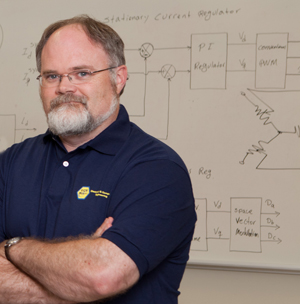New method for building a low-cost, high-performance electric machine and drive could result in huge energy savings
Prof. Hofmann intends to design, build and test a 30kW brushless, self-excited synchronous field winding prototype machine that overcomes the weaknesses of the current technology.

 Enlarge
Enlarge
Prof. Heath Hofmann will be expanding his impact on the field of electric machines and drives in a newly funded project supported by the Bosch Energy Research Network. The research could potentially result in huge energy savings due to the widespread use of these machines and the applicability of Hofmann’s research project to these devices.
Electric machines are used in variable speed drive applications such as the propulsion of hybrid electric vehicles, and there are different methods that engineers consider to achieve similar results. One of the more popular methods requires rare earth materials. However, the cost of these materials has skyrocketed in recent years, leading researchers to consider alternative methods.
A promising candidate that could replace conventional machines in variable-speed drives is the synchronous field winding machine. These machines are constructed of low-cost materials, such as iron and copper, and have relatively low manufacturing cost. However, up to this point, the need to provide power to the field coils on the rotor has created too many associated problems to make this method viable.
Over the next 2 years, Prof. Hofmann intends to design, build and test a 30kW brushless, self-excited synchronous field winding prototype machine that overcomes the weaknesses of the current technology. The result will be a low-cost, high-performance electric machine and drive.
How low cost? The propulsion motor of the Toyota Prius requires neodymium-iron-boron magnets at a cost of approx. $100/lb. Hofmann’s design replaces these magnets with copper, at a current cost of $4/lb.
“In addition to vehicular applications,” stated Hofmann, “the proposed motor design could replace induction machines in many variable-speed drive applications. It is anticipated that the proposed machine will be more efficient than induction machines, and provide more power over a wider speed range, at about the same cost.” Induction machines are the most common type of motor used in industrial, commercial, and residential settings, and consume a large percentage of all the electrical energy generated in a system.

 Enlarge
Enlarge
The project is called, “Brushless, Self‐Excited Synchronous Field‐Winding Machine,” and is funded by Bosch as part of a new $10M initiative, called the Bosch Energy Research Network (BERN). BERN was created to promote energy research and education in the United States, build relationships with top faculty researching energy topics, and attract the best engineering talent to the industry. Hofmann’s project is one of only 7 new projects funded in transformative energy technology in this first phase of funding. The University of Michigan was one of only 5 institutions invited to submit proposals in the initial phase of funding.
Prof. Hofmann is a specialist in the field of power electronics, particularly in the design, analysis, and control of electromechanical systems. He has extensive experience in the design and control of electric machines, and his work includes a flywheel energy storage system (still in development) and the creation of a robust control algorithm for an induction machine drive (for Tesla Motors). He currently teaches courses in Electric Machinery and Drives, and Power Electronics, and is introducing the special topics course, Electromechanics, in 2012.
 MENU
MENU 
